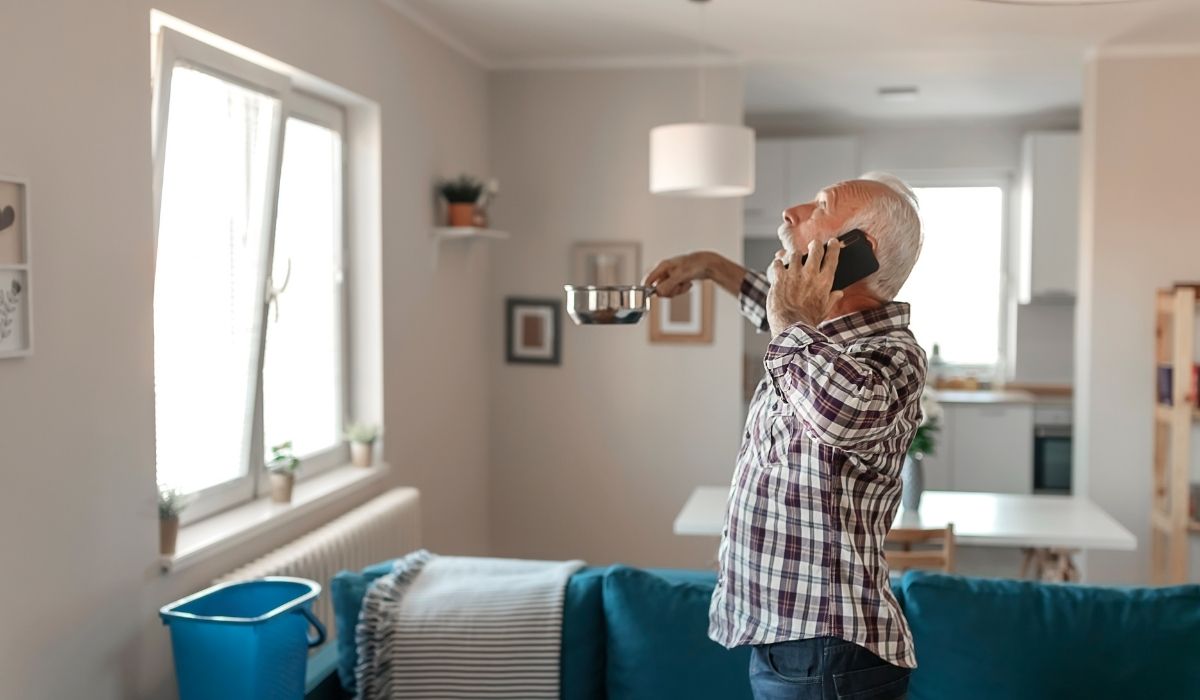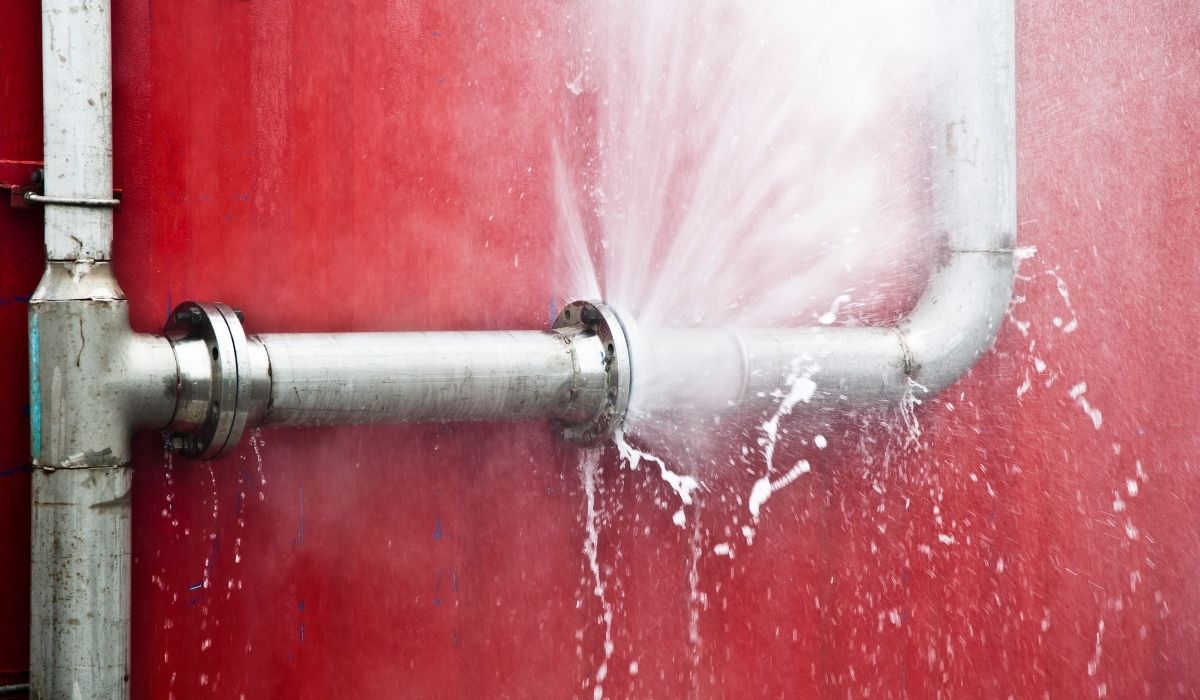Insights Into the Water Damage Restoration Process for Homes
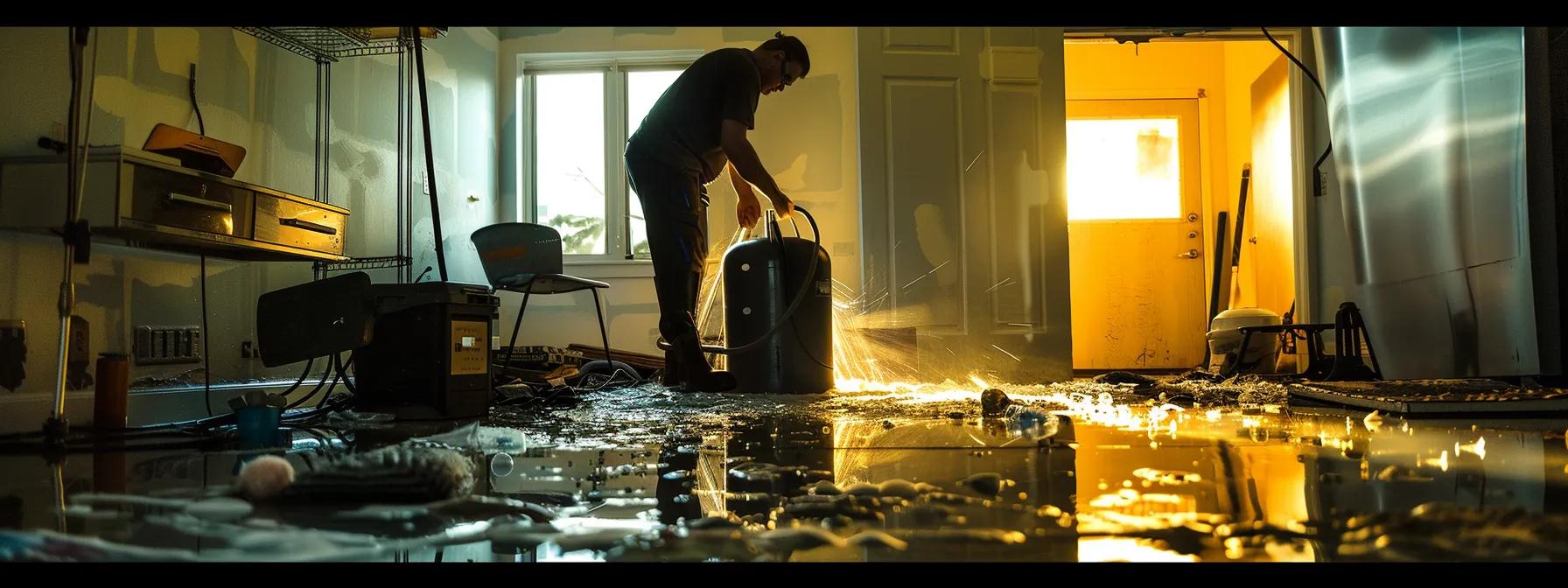
Water Damage Restoration Process: Step-by-Step
In any property, unexpected water damage can cause significant disruption, structural harm, and even health issues, particularly when coupled with mold growth or contamination. Homeowners and property managers must act quickly and efficiently in these scenarios to prevent further deterioration and avoid costly repairs. This comprehensive guide outlines a step-by-step water damage restoration process—from the initial response and assessment to final inspection and post-restoration actions. The article discusses emergency management measures that incorporate modern tools like moisture meters, dehumidifiers, and advanced drying techniques. It also highlights essential safety measures, including the use of personal protective equipment (PPE), proper handling of contaminated water, and protocols for addressing electrical hazards during water intrusion incidents. Furthermore, the guide integrates peer-reviewed research studies, expert recommendations on water remediation processes, and detailed lists of best practices for each stage of restoration. With structural drying, debris removal, and reconstruction steps all explained in detail, this resource serves as an invaluable tool for anyone facing water damage in a residential or commercial setting. Homeowners are encouraged to involve professional restoration companies that use scientific methods to measure humidity, airflow, and contamination levels. The careful documentation of damage assists in accurate insurance claims and provides a clear roadmap for long-term structural repairs. Ultimately, this article prepares readers with actionable insights that not only restore safety and functionality but also prevent future water-related crises.
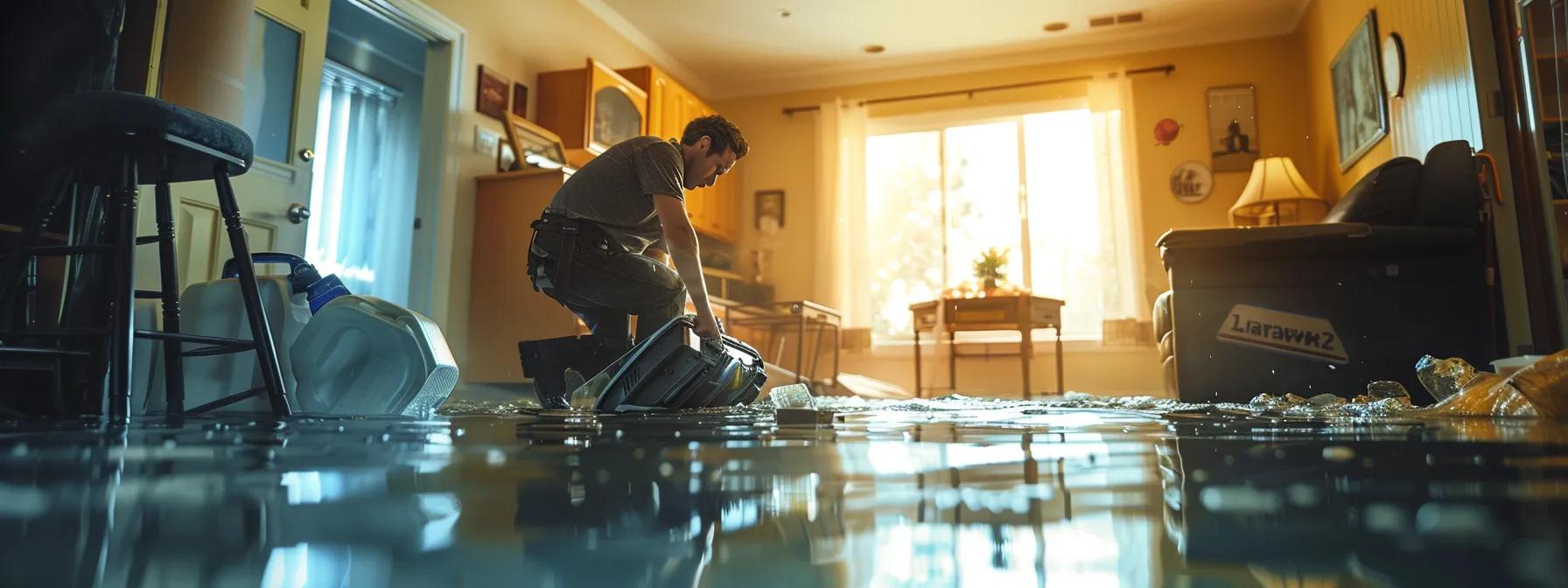
Initial Response and Water Damage Assessment
Immediate action following water damage is crucial to minimize destruction and potential health risks. The first steps include identifying the water source and determining whether the water is clean, gray, or black, which influences the remediation process. Homeowners should ensure that any water damage is quickly assessed to determine both the immediate and long-term steps required for effective restoration. This section outlines how to evaluate water intrusion, assess the extent of the damage, and plan for further remediation.
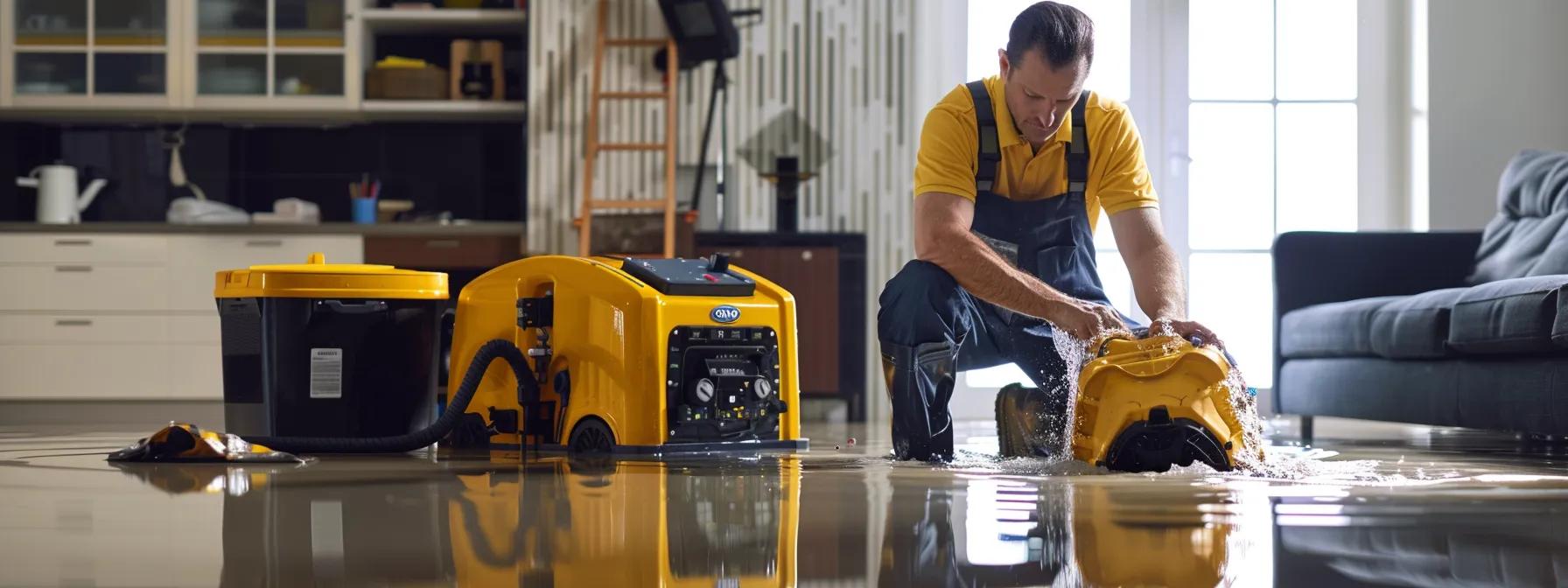
Identifying the Water Source and Type
The first step in any water damage restoration process is to identify where the water is coming from. This includes determining if the source is due to natural disasters such as floods or storms, internal malfunctions like leaking pipes or faulty appliances, or external sources such as roof leaks or drainage failures. Professional restoration companies use moisture meters and thermal imaging cameras to assess the water type and its spread, enabling them to distinguish between clean water from broken water lines, gray water due to appliance malfunctions, and hazardous black water that may contain sewage or contaminants. Accurate identification is essential because it directly influences the safety protocols and treatment procedures required for cleaning and disinfection.
Evaluating the Extent of Water Intrusion and Affected Areas
After identifying the source, evaluating how far the water has intruded into building materials such as drywall, insulation, and flooring is critical. This assessment helps determine whether items can be salvaged or must be disposed of immediately. Professionals inspect areas not only exposed to visible water but also hidden spaces like behind walls and under flooring where moisture can linger and foster mold growth. Utilizing advanced tools, such as humidity sensors and moisture meters, experts gather data that supports the restoration plan and ensures that any remaining moisture is effectively removed.
Classifying the Water Contamination Level for Safety
Water contamination levels are classified into categories based on their quality. Clean water (Category 1) poses the least health risk, while gray water (Category 2) contains contaminants that may cause discomfort or minor illness. Black water (Category 3) is highly contaminated and poses significant health hazards, necessitating strict safety protocols during the restoration process. Safety classifications help determine the required level of personal protective equipment (PPE) and the disinfection processes needed to restore safe indoor air quality. Following established guidelines from environmental agencies, restoration professionals mitigate risks by following proper containment and disinfection procedures to safeguard all residents.
Documenting Damage for Insurance Claims
Proper documentation is a critical part of the restoration process, particularly for insurance claims. Detailed records of affected areas, photographs, moisture readings, and water source analysis are essential. This documentation not only assists in repair planning but also provides critical evidence to support claims with home insurance companies. Accurate records ensure that all damage—both visible and hidden—is accounted for, which can ultimately lead to a fair settlement from insurers.
Establishing a Preliminary Water Mitigation Plan
Once the assessment and documentation are complete, a preliminary mitigation plan is established. This plan outlines the immediate actions required to stop further water intrusion and begins the process of water removal and structural drying. It includes emergency measures such as turning off the main water supply, isolating affected zones, and preparing the necessary equipment for water extraction. The mitigation plan is crucial as it sets the stage for a methodical and safe restoration process, ensuring that subsequent steps are executed efficiently.
Key Takeaways: – Immediate assessment saves money and prevents further structural damage. – Identification of water source and type sets appropriate safety and treatment protocols. – Detailed documentation supports insurance claims. – A clear preliminary mitigation plan is essential for efficient restoration.
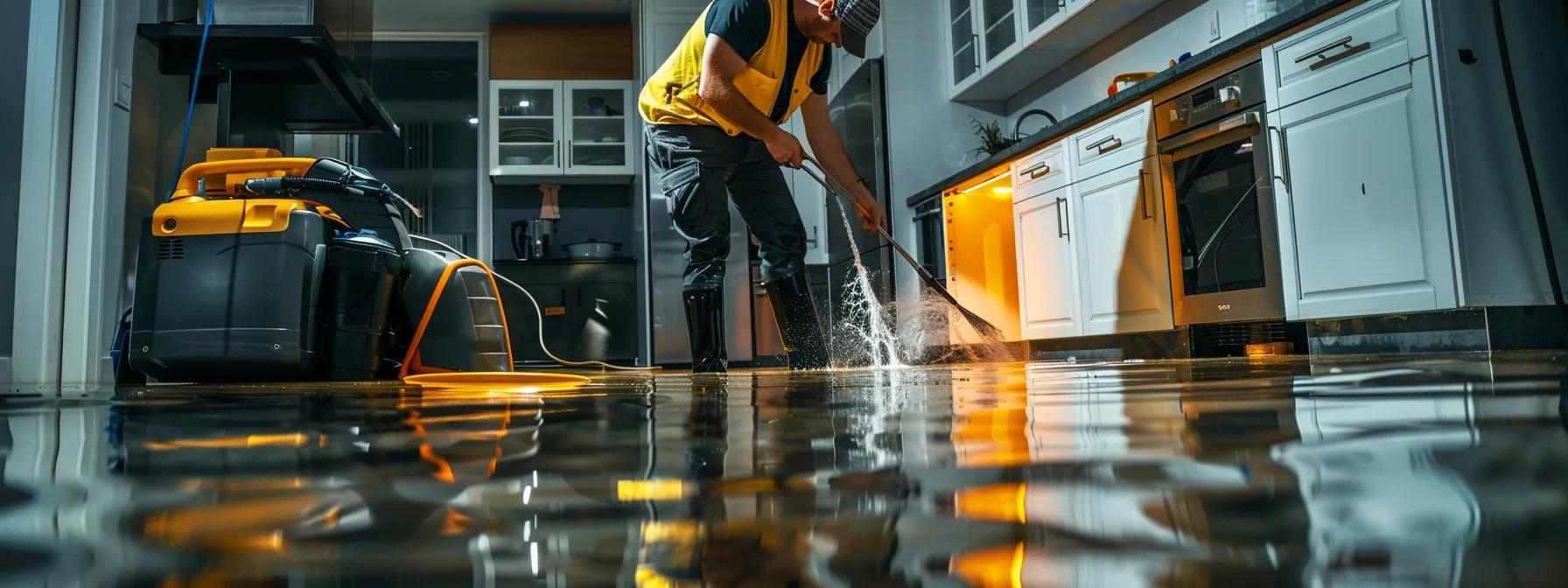
Executing Water Mitigation Steps for Damage Control
After assessing the water damage, the next phase is executing damage control measures to limit further deterioration. This involves the swift removal of standing water, safeguarding unaffected property, and addressing safety hazards. Every minute counts to prevent secondary damage such as mold growth, structural corrosion, or electrical hazards. Professionals must act decisively, mobilizing high-powered extraction tools and strategic planning to ensure that all immediate threats are neutralized.
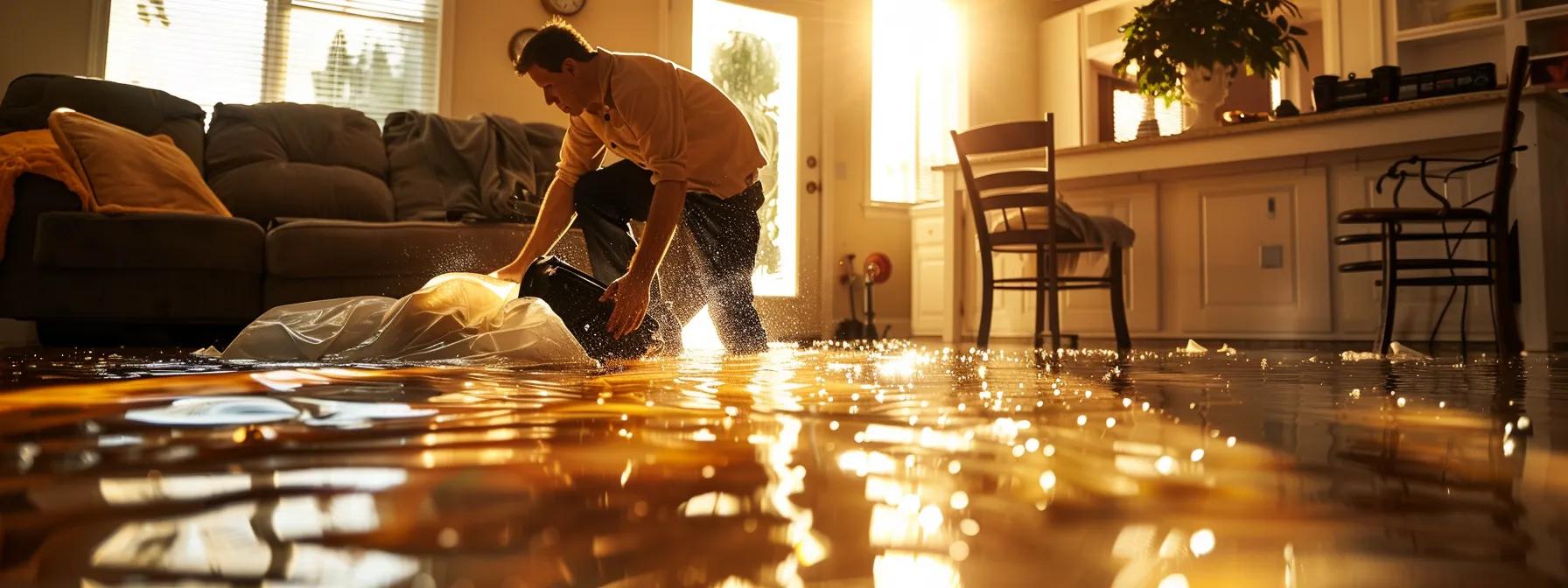
Swift Removal of Standing Water and Excess Moisture
The prompt extraction of standing water is critical to preventing structural damage and minimizing the potential for mold growth. Using industrial-grade submersible pumps and wet vacuums, restoration professionals remove water from floors and other lower-level areas as quickly as possible. The process often involves multiple passes to eradicate all traces of surface water and relies on calibrated moisture meters to verify completion. Comprehensive water extraction prevents further absorption into building materials, reducing the need for extensive repairs later. This swift action not only preserves the building’s integrity but also supports a safer restoration environment.
Protecting Unaffected Areas and Belongings
An important component of water mitigation is safeguarding unaffected areas and personal belongings. Restoration experts isolate the damaged zones using plastic sheeting and barriers, preventing cross-contamination with non-affected spaces. High-value items and furniture that have avoided saturation are carefully moved and stored in dry, secure locations to preserve their condition. This preliminary protection is integral to ensuring a controlled environment where the water damage can be contained and effectively managed.
Addressing Safety Hazards Like Electrical Issues
Electrical hazards represent a severe risk in water-damaged properties. Professionals immediately disconnect power sources to reduce the risk of short circuits, electrocution, or fire. An inspection follows to identify electrical systems that may have been compromised by moisture exposure. Tools like infrared cameras assist in spotting potential problems hidden behind walls or under flooring. Specialized electricians assess and rectify any issues, ensuring that restored areas meet current safety standards.
Removing Waterlogged and Unsalvageable Materials
Items and furnishings heavily saturated with water require removal to prevent the spread of contaminants and mold. Determining which materials are unsalvageable involves measuring moisture content and evaluating degradation levels. Carpets, drywall, insulation, and sometimes even structural wood may be removed if moisture absorption exceeds safe thresholds. These actions make way for thorough cleaning and future repairs while ensuring that contaminated materials never contribute to secondary water damage.
Implementing Temporary Repairs to Stop Further Water Entry
Temporary measures are implemented to prevent additional water intrusion while permanent repairs are planned. This may include sealing leaks, applying waterproof tarps, or installing temporary barriers around affected zones. The goal is to halt the source of the problem—whether it’s a broken pipe, leaking roof, or faulty appliance—while the broader restorative measures are being executed. These short-term fixes form the foundation of a comprehensive restoration strategy and allow for safe and controlled water extraction and drying processes.
Key Takeaways: – Fast water extraction limits structural damage and mold development. – Protecting undamaged areas preserves belongings and reduces additional losses. – Immediate electrical hazard management is essential for safety. – Removing unsalvageable materials prevents secondary contamination. – Temporary fixes are crucial to halt further water entry and enable effective restoration.
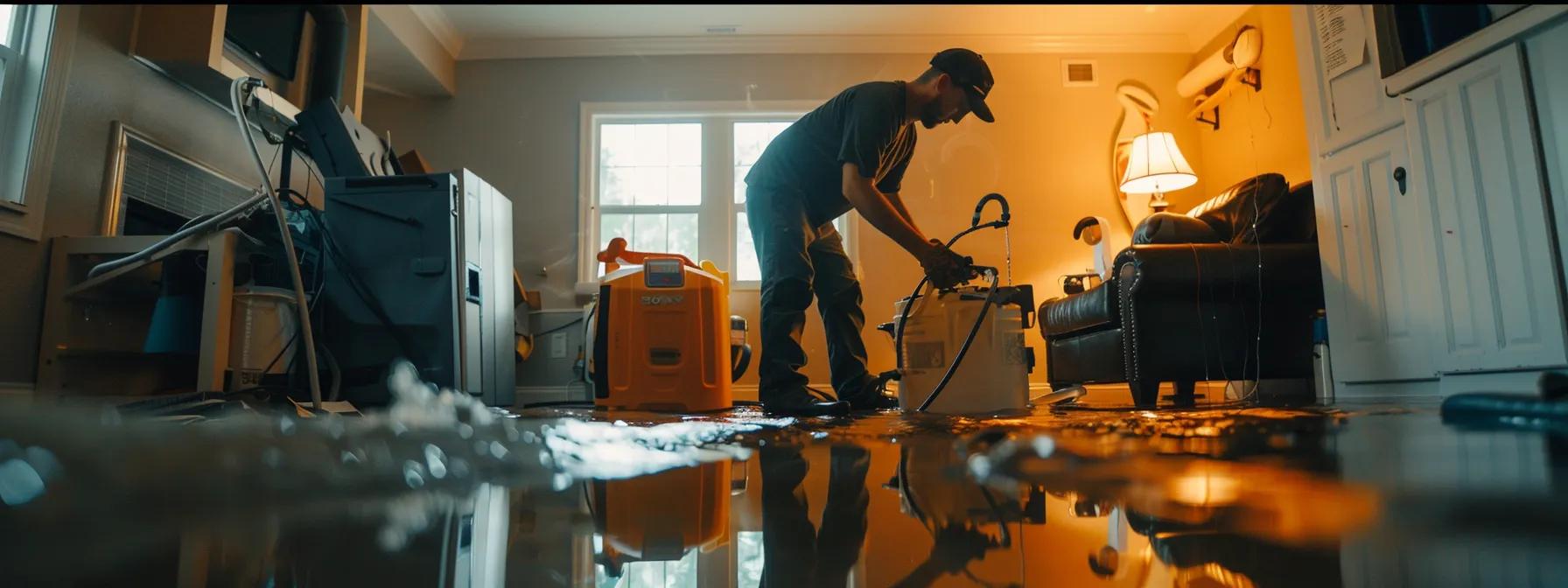
Thorough Drying Water Damaged Areas and Dehumidification
Drying water-damaged structures is a pivotal part of the restoration process. Efficient drying prevents mold growth, reduces the risk of further structural damage, and ensures long-term indoor air quality. The use of advanced dehumidifiers and industrial air movers is common in this phase. By aggressively removing moisture and carefully monitoring humidity levels, restoration teams ensure that every nook and cranny is free from water residue.
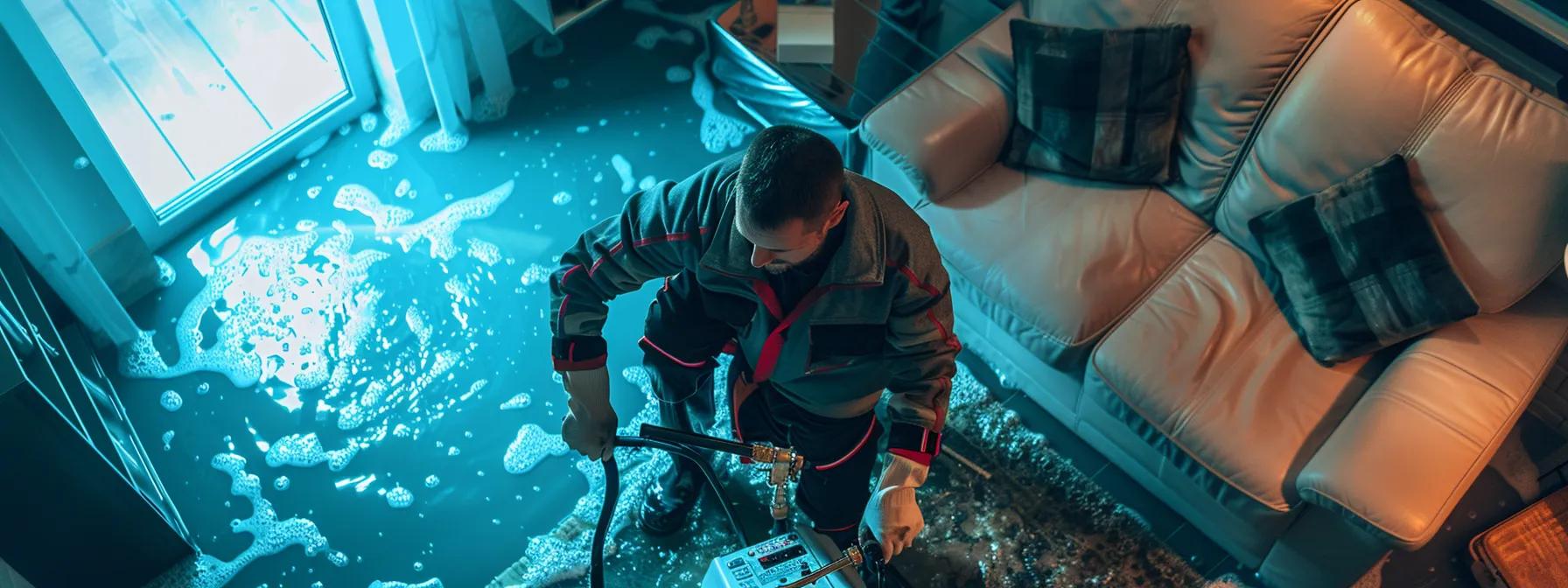
Utilizing Industrial Air Movers for Enhanced Air Circulation
Industrial air movers are deployed to accelerate the drying process by increasing air circulation around water-damaged structures. These high-powered fans move vast volumes of air, effectively evaporating moisture from walls, ceilings, and floors. Air movers, strategically placed in damaged areas, reduce drying times significantly. The distribution of airflow ensures that even hidden pockets of moisture, such as under carpet or behind drywall, are exposed to drying conditions. The increased circulation also aids in reducing the ambient humidity within the space, thereby enhancing the overall efficiency of dehumidification efforts.
Employing Dehumidifiers to Extract Atmospheric Moisture
Dehumidifiers work in tandem with air movers to pull moisture from the air and affected materials. By maintaining optimal moisture levels, dehumidifiers prevent the formation of mold and mildew. Modern units are equipped with digital hygrometers and sensors, which allow technicians to monitor humidity levels in real time. These devices automatically adjust operations based on ambient conditions to execute a precise water extraction process. In many cases, industrial dehumidifiers are capable of extracting dozens of liters of moisture per day, significantly expediting the drying process and safeguarding structural integrity.
Monitoring Moisture Levels in Structures and Air
Continuous monitoring is vital to ensure that drying efforts have completely eliminated excess moisture. Restoration professionals use moisture meters and thermal imaging cameras to assess both visible areas and concealed spaces within walls and floors. Regular measurements are recorded to track the progress of the drying process. This data provides a comprehensive snapshot that informs decisions about when to remove equipment and begin restoration repairs. Such vigilant monitoring minimizes the chances of residual moisture that could later lead to mold growth or structural weakening.
Applying Specialized Techniques for Drying Concealed Spaces
Concealed spaces, such as behind insulation or under built-in cabinetry, often require advanced drying techniques. Professionals may employ specialized drying mats, inject air directly into wall cavities, or use infrared technology to locate trapped moisture. These techniques ensure that no hidden reservoirs of water remain, which could otherwise compromise the long-term health of the structure. By addressing these challenging areas, restoration experts not only protect the integrity of the property but also provide assurance to homeowners that every potential hazard has been eliminated.
Ensuring Complete Dryness to Prevent Secondary Damage
The final stage in the drying process is to verify that every area has reached complete dryness. This verification includes re-checking moisture levels, confirming that all equipment readings are within safe thresholds, and ensuring that environmental conditions are not conducive to mold growth. Comprehensive testing confirms that the risks of secondary damage, such as corrosion or bacterial proliferation, have been minimized. Effective drying and dehumidification ultimately help prevent long-term structural decay and promote a safe, healthy living environment.
Key Takeaways: – Industrial air movers and dehumidifiers work synergistically to speed up drying. – Consistent monitoring ensures that all areas, including hidden spaces, are thoroughly dried. – Specialized techniques target areas that standard equipment may miss. – Complete dryness is essential to avoid secondary damage like mold. – Data-driven monitoring validates the success of the drying process.
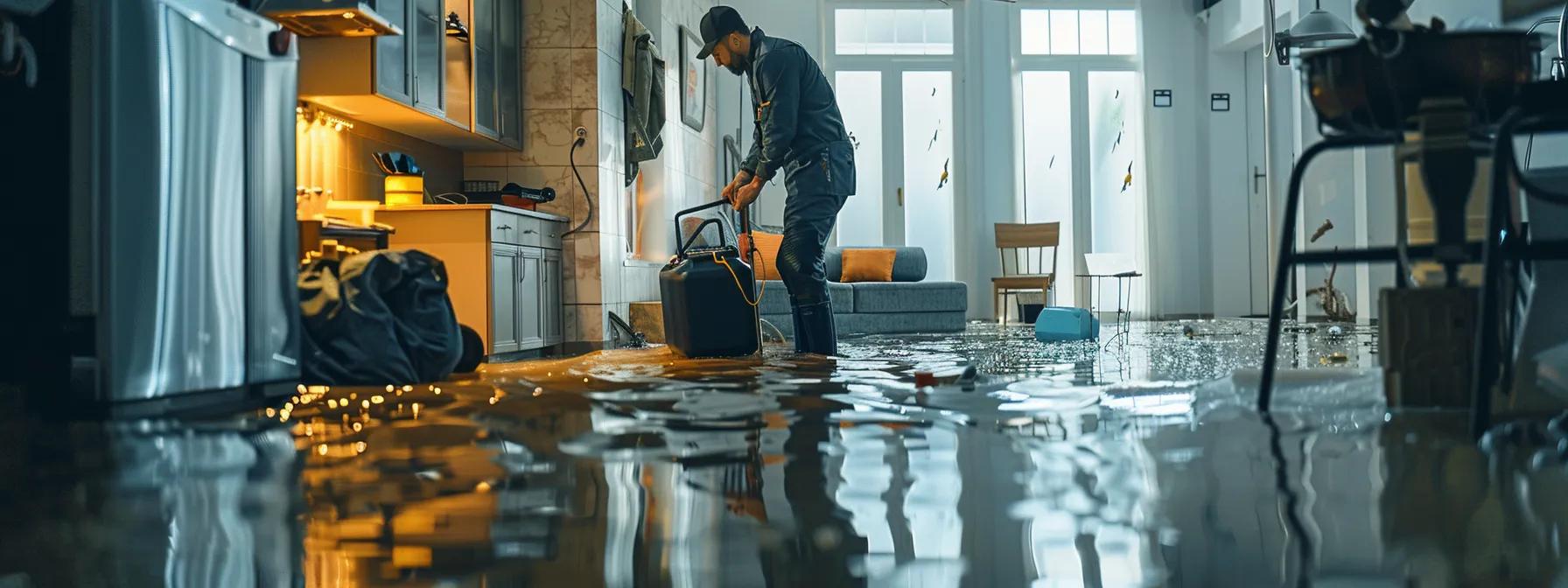
Cleaning, Sanitizing, and Deodorizing Affected Zones
Once moisture levels have been reduced, cleaning, sanitizing, and deodorizing become paramount steps. This stage addresses both the physical and microbial contaminants introduced by water damage. Using recommended guidelines and antimicrobial treatments, restoration specialists eliminate harmful pathogens, inhibit mold growth, and remove lingering odors. Proper cleaning not only restores aesthetics but also ensures the space is safe for occupancy.
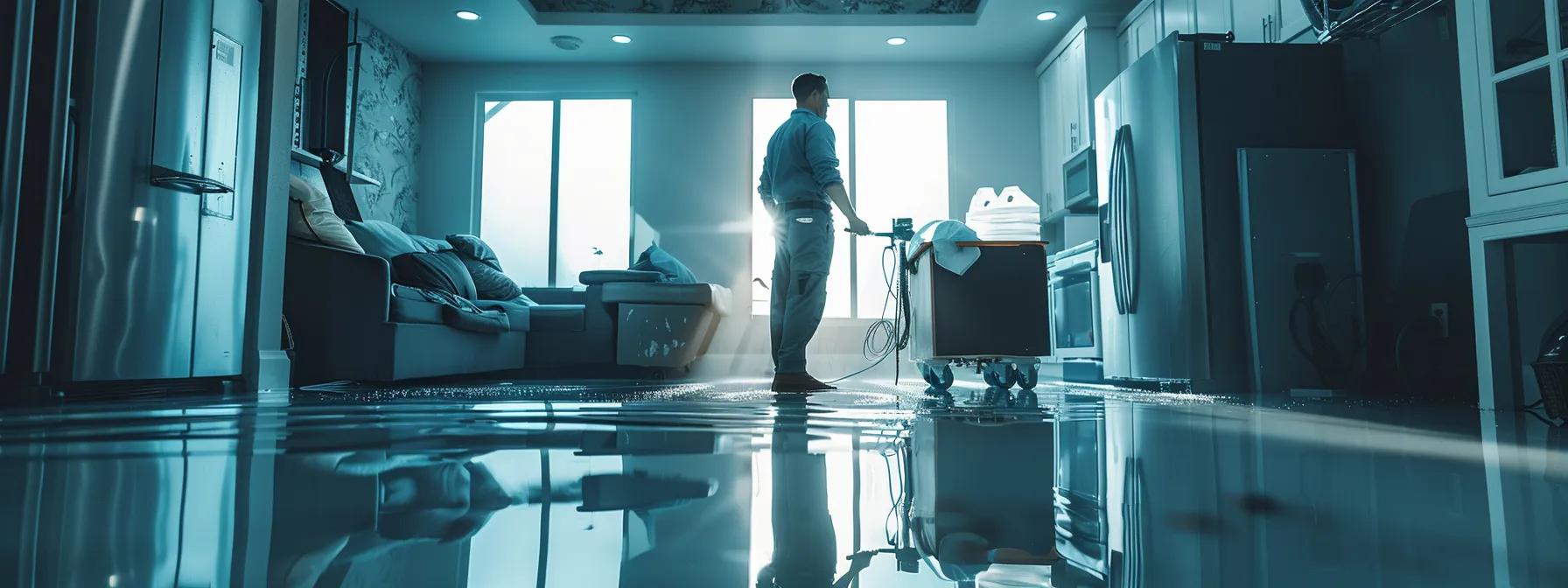
Thorough Cleaning of All Affected Surfaces and Items
Restoration begins with the deep cleaning of all water-exposed surfaces, including walls, floors, and personal belongings that can be salvaged. This process involves the use of high-grade cleaning agents, detergents, and sometimes specialized tools like scrubbers or pressure washers to remove debris, dirt, and microbial contaminants. Surfaces are carefully evaluated, and items that show signs of extensive water penetration are either thoroughly cleaned or set aside for disposal. Special attention is given to porous materials, which may require repeated cleaning cycles. Through these methods, the immediate impacts of water damage are reduced, paving the way for subsequent sanitization.
Applying Antimicrobial Treatments to Inhibit Mold and Bacteria
To mitigate the risk of mold growth and bacterial contamination, antimicrobial treatments are applied to affected zones. These biocidal chemicals, often proven by peer-reviewed studies such as one conducted by the International Journal of Environmental Research and Public Health (2021), have been shown to reduce microbial counts by over 90%. By treating surfaces, restoration teams inhibit the growth of mold spores and bacteria that thrive in moist environments. The proper usage of these chemicals not only preserves the integrity of materials but also significantly improves indoor air quality, ensuring a healthful living space.
Sanitizing Surfaces to Ensure a Healthy Environment
Beyond cleaning and antimicrobial treatments, sanitizing all touched surfaces is essential for preventing potential health hazards. Using disinfectants approved by agencies like the EPA, restorer teams scrub and wipe surfaces, ensuring that any residual pathogens are neutralized. This step frequently involves the use of foggers or electrostatic sprayers to reach crevices and complex surfaces. In doing so, the sanitization process creates a safe environment and alleviates any concerns about lingering contaminants that could lead to sickness or worsen existing conditions.
Using Deodorization Techniques to Remove Unpleasant Odors
Water damage often leaves behind persistent, unpleasant odors. Deodorization techniques such as thermal fogging, ozone treatment, or the application of enzyme-based products are implemented to neutralize these smells. These methods break down odor-causing compounds at a molecular level. For instance, modern ozone generators have been shown by controlled studies to reduce persistent odors in water-damaged areas by over 80% within several hours. These treatments restore a sense of freshness and contribute to the overall recovery of the living environment.
Cleaning and Restoring Salvageable Personal Belongings
Personal belongings affected by water damage require specific attention. Restoration experts often use a combination of cleaning, deodorizing, and drying techniques to salvage items like furniture, documents, and sentimental objects. Each item is evaluated individually for restoration potential. Items that can be saved are meticulously cleaned using specialized products that remove both physical contaminants and any associated odors. This careful process not only preserves the value of personal property but also reduces the overall cost of restoration by salvaging irreplaceable items.
Key Takeaways: – Deep cleaning removes physical and microbial contaminants. – Antimicrobial treatments dramatically reduce the risk of mold and bacteria. – Comprehensive sanitization ensures a safe, healthy environment. – Deodorization techniques effectively neutralize persistent water damage odors. – Salvaging personal belongings adds value and reduces restoration costs.
Comprehensive Water Damage Restoration and Repairs
After drying and cleaning, thorough structural repairs bring the property back to its original state. This phase integrates both aesthetic and functional restoration, ensuring that every damaged component is addressed. The process involves a detailed evaluation of structural integrity, repair or replacement of damaged materials, and finishing touches that return the space to a livable condition. In this stage, skilled trades and restoration specialists work together, utilizing industry tools and construction techniques to rebuild with precision.
Repairing or Replacing Damaged Structural Components
Structural components such as beams, joists, and load-bearing walls may suffer extensive damage from prolonged water exposure. Restoration crews assess the integrity of these elements and decide whether repairs or full replacements are necessary. Using techniques grounded in building science and local construction codes, professionals stabilize the structure to ensure safety and durability. This includes reinforcing existing members or installing new ones where damage is too severe. Expert evaluation often involves ultrasonic testing and moisture detection devices to ensure that all damage is accurately addressed before reconstruction begins.
Restoring Damaged Drywall, Flooring, and Insulation
Drywall and flooring are commonly affected during water damage incidents. Restoration professionals remove and dispose of waterlogged materials, replacing them with new drywall, underlayment, and flooring as needed. Insulation, which can harbor significant moisture and mold, is also replaced when compromised. Standard protocols involve sealing and waterproofing techniques to prevent future occurrences, and in many cases, antimicrobial treatments are applied to the new materials to safeguard against mold growth. This comprehensive restoration ensures that internal finishes not only look new but also contribute to the building’s long-term structural health.
Addressing HVAC System Cleaning and Restoration if Needed
Water damage can severely impact HVAC systems, embedding moisture and contaminants within ductwork and mechanical components. A full cleaning of the HVAC system—including duct sanitization using HEPA filters and antimicrobial sprays—is critical for restoring air quality and ensuring system efficiency. In some cases, components such as coils or filters may require replacement. Restoration experts pay special attention to any signs of corrosion or residue buildup, which may indicate deeper mechanical issues. Ensuring that the HVAC system is properly restored prevents problematic recirculation of moisture and contaminants throughout the property.
Painting and Finishing Touches to Restore Appearance
Once structural repairs and replacements are complete, cosmetic restoration takes priority. This includes painting, installing flooring, and refining trim work to return the property to a visually appealing state. Quality paint formulations designed for moisture-prone areas are applied to prevent future damage, and finishing touches are addressed meticulously. Contractors use moisture-resistant paints and primers to ensure that the repaired areas maintain their durability and aesthetic integrity over time. These steps ensure that the restoration is comprehensive—both functionally and visually pleasing.
Rebuilding Severely Damaged Areas of the Property
In cases where water damage has compromised entire sections of a property, complete rebuilding may be necessary. This involves the demolition of unsalvageable materials, followed by the reconstruction of walls, ceilings, or even entire rooms. Rebuilding projects are carried out in strict compliance with building codes and safety regulations. Modern construction techniques and materials, including moisture barriers and advanced insulation products, are incorporated to enhance the property’s resilience against future water incidents. Such comprehensive repairs restore structural integrity and ensure that the living spaces are safe and attractive.
Key Takeaways: – Structural repairs are tailored to the severity of water damage. – Damaged drywall, flooring, and insulation are replaced with durable, moisture-resistant materials. – HVAC system cleaning is critical to restoring air quality. – Cosmetic restoration enhances both function and visual appeal. – Rebuilding severely damaged areas ensures a comprehensive recovery.
Final Inspection and Post-Restoration Actions
The final phase of water damage restoration is a detailed inspection and evaluation of restored areas. A comprehensive walkthrough ensures that all moisture, contaminants, and residual damages have been addressed and that every component meets established safety and quality standards. This concluding process not only verifies that the property is fully restored but also plans for preventative measures to mitigate future incidents. Final inspections involve collaboration between restoration experts, structural engineers, and sometimes local building authorities, providing a robust check on the overall work performed.
Conducting a Final Walkthrough to Confirm Restoration Quality
A final walkthrough is conducted by the restoration team to confirm that all repairs, cleaning, and drying processes have been executed to the highest standards. During this walkthrough, every room is thoroughly inspected, and moisture levels are rechecked using calibrated hygrometers and infrared cameras. Any areas that require touch-ups are noted and addressed immediately. The final walkthrough is crucial for ensuring that there are no residual issues and that the property is genuinely safe for re-occupation.
Verifying Elimination of All Moisture and Contaminants
Verifying that all moisture has been completely eliminated is essential to prevent mold and further structural damage. Restoration professionals re-test surfaces and use moisture meters in both obvious and hidden areas to confirm that drying benchmarks are met. Additionally, air quality assessments are performed to ensure that any contaminants, such as microbial spores or residual chemicals from cleaning agents, have been effectively eradicated. These re-verification procedures provide the assurance that the space is entirely free of hazardous moisture and is safe for daily use.
Reviewing Completed Repairs and Reconstruction
After the final assessments, a detailed review of all completed repairs is conducted. This review involves checking that newly installed materials, such as drywall and flooring, are seamlessly integrated with existing structures. Restoration experts also evaluate the consistency and durability of the finished work. Construction photos, detailed reports, and test results are compiled to validate the quality of the repair work. This review process ensures that the restoration aligns with industry standards and client expectations.
Discussing Preventative Measures for Future Water Damage
Once restoration is complete, professionals advise homeowners on steps to prevent future water damage. This may involve routine maintenance of plumbing systems, installation of improved drainage solutions, and upgrading waterproofing measures on roofs and foundations. Educating property owners on regular inspections and proper response strategies for early signs of moisture can be invaluable. Suggestions include installing moisture sensors, scheduling periodic home inspections, and engaging professional emergency services at the first signs of water intrusion. These proactive measures can significantly reduce the risk of recurring water damage.
Ensuring Client Satisfaction With the Water Damage Restoration Process
Client satisfaction is the cornerstone of any restoration project. After all tasks are completed, the restoration team holds a post-restoration consultation with the homeowner to discuss the work performed and address any remaining concerns. Feedback is gathered regarding the overall service, and any minor adjustments are scheduled promptly. This step ensures that the client is confident in the restoration quality and is equipped with the knowledge to prevent future issues. It also provides a final opportunity for the restoration company to demonstrate their commitment to excellence and long-term customer care.
Key Takeaways: – Final inspections confirm that all moisture and contaminants have been eliminated. – A detailed review ensures that repairs meet quality and safety standards. – Preventative measures are essential for avoiding future water damage. – Client satisfaction and post-restoration consultations are integral to the process. – Comprehensive final checks provide lasting assurance of property safety.
Conclusion
Water damage restoration is a multifaceted process that requires immediate action, thorough assessment, and precise execution at every stage. From the initial response and damage evaluation to the strategic drying, cleaning, and reconstruction, each step is critical for ensuring safety and preventing long-term challenges such as mold and structural decay. This comprehensive guide has outlined the best practices and technical procedures—supported by advanced equipment and scientific studies—that restoration professionals follow to return a damaged property to a safe, livable condition. Homeowners are encouraged to invest in proper emergency management and consider professional services that provide detailed diagnostics, effective water extraction, and comprehensive repairs. By adopting proactive maintenance and prevention strategies, future incidents can be minimized, safeguarding both property and health.
Frequently Asked Questions
Q: What immediate steps should be taken after discovering water damage? A: Immediately shut off the water source and electricity, then document the damage with photos and moisture readings. Contact a professional restoration company to evaluate the extent of the damage and begin water extraction and drying procedures.
Q: How do restoration professionals determine the contamination level of water damage? A: They classify water as clean, gray, or black using moisture meters and visual inspections. Black water, which is highly contaminated, requires specialized safety measures and antimicrobial treatments to prevent health hazards.
Q: What types of equipment are typically used in the drying process? A: Industrial air movers, dehumidifiers, infrared cameras, and moisture meters are essential. These tools help speed up drying by enhancing air circulation and monitoring moisture levels in hidden areas like walls and floors.
Q: How is mold prevented after water damage? A: Mold is prevented by swiftly extracting moisture, thoroughly drying affected materials, and applying antimicrobial treatments along with regular monitoring of humidity levels. Proper cleaning and sanitization are also crucial components of mold prevention.
Q: What role does insurance play in water damage restoration? A: Insurance companies rely on detailed documentation of all damages for claims. Homeowners should keep records of inspections, moisture readings, and photos. A professional restoration service can provide comprehensive reports to support insurance claims and facilitate a fair evaluation.
Q: Can water damage affect the HVAC system? A: Yes, water damage can infiltrate HVAC systems, leading to contaminated air circulation. Restoration professionals often clean and sanitize ductwork, replace filters, and inspect system components to ensure safe indoor air quality after water damage.
Q: How often should homeowners schedule inspections to prevent water damage? A: Regular inspections, ideally annually or after severe weather events, are recommended. Proactive maintenance and early detection can prevent major water damage and mitigate the risks of mold and structural deterioration.


